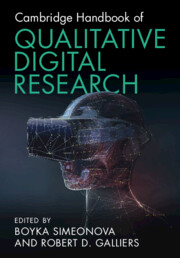Book contents
- Cambridge Handbook of Qualitative Digital Research
- Cambridge Handbook of Qualitative Digital Research
- Copyright page
- Contents
- Figures
- Tables
- Contributors
- Preface
- Part I Philosophical, Epistemological and Theoretical Considerations
- Chapter 1 Introduction
- Chapter 2 A Philosophical Perspective on Qualitative Research in the Age of Digitalization
- Chapter 3 Data as a Contingent Performance and the Limitations of Big Data
- Chapter 4 Big Data, Little Understanding
- Chapter 5 Power, Knowledge and Digitalization
- Chapter 6 Information Technology and Power
- Part II Methodological Considerations
- Part III Illustrative Examples and Emergent Issues
- Index
- References
Chapter 3 - Data as a Contingent Performance and the Limitations of Big Data
from Part I - Philosophical, Epistemological and Theoretical Considerations
Published online by Cambridge University Press: 08 June 2023
- Cambridge Handbook of Qualitative Digital Research
- Cambridge Handbook of Qualitative Digital Research
- Copyright page
- Contents
- Figures
- Tables
- Contributors
- Preface
- Part I Philosophical, Epistemological and Theoretical Considerations
- Chapter 1 Introduction
- Chapter 2 A Philosophical Perspective on Qualitative Research in the Age of Digitalization
- Chapter 3 Data as a Contingent Performance and the Limitations of Big Data
- Chapter 4 Big Data, Little Understanding
- Chapter 5 Power, Knowledge and Digitalization
- Chapter 6 Information Technology and Power
- Part II Methodological Considerations
- Part III Illustrative Examples and Emergent Issues
- Index
- References
Summary
The proliferation of digital data has been presented as heralding a revolution in research methods for the study of social phenomena, such as IS. For some authors, this revolution involves the abandonment of the traditional scientific method in favour of purely inductive data-driven research. Others proclaim the emergence of a new, quantitative, computational social science that will displace qualitative methods, while others see digital data as potentially enriching qualitative research. All these claims, however, take the nature of data for granted, assuming that they straightforwardly instrument reality and that understanding of the world can therefore be gained through their analysis alone. This chapter presents a critical analysis of this ‘pre-factual’ view, arguing that data are not natural givens, but are performed, brought into being by situated practices that enact particular representations of the world. The implications of such a conceptualization of data for research methods in Information Systems and organizational research are discussed.
- Type
- Chapter
- Information
- Cambridge Handbook of Qualitative Digital Research , pp. 28 - 42Publisher: Cambridge University PressPrint publication year: 2023



